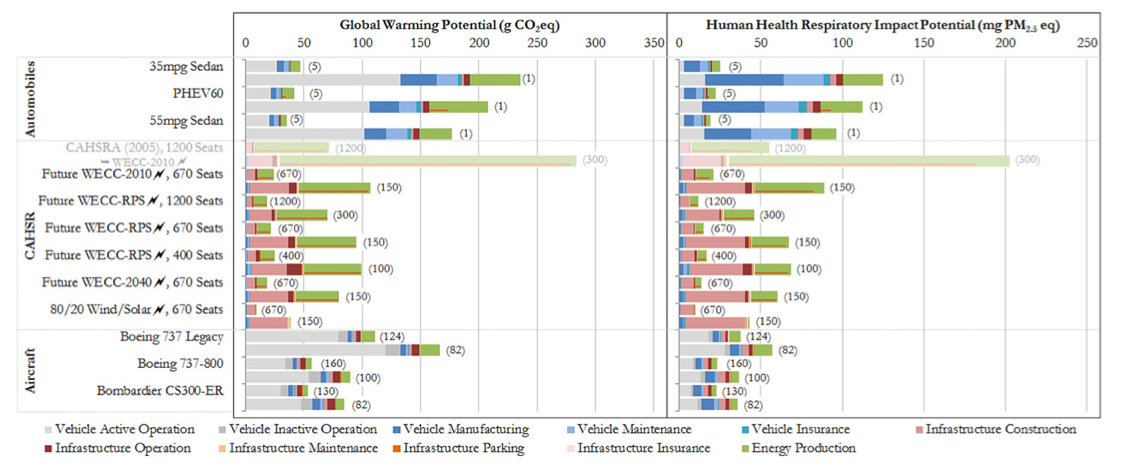ENVIRONMENTAL RESEARCH LETTERS
by Mikhail Chester, Arizona State University and Arpad Horvath, University of California Berkeley
Background
Deployment of new and more fuel-efficient transportation modes is expected in the coming decades. Next generation automobiles and aircraft are already entering the market.
Despite major political and economic roadblocks in the United States, federal, state, and regional transportation and land-use planners are discussing high-speed rail (HSR) as a potentially better investment for future mobility. The discussion of new transportation options is often coupled with the identification of strategies to help reduce congestion and travel times. With increasing populations and long-distance transportation demand forecasts, HSR was made a centerpiece of the American Recovery and Reinvestment Act as a modal diversification strategy. While several corridors are under study, California in 2008 authorized $9.95 billion in bonds for their 1200 km system and the state legislature recently approved funding to start construction. Engineering and planning work are already underway, with possible groundbreaking in 2013 (CAHSRA 2012). While many technical, legal, economic, community and political battles loom, the California HSR (CAHSR) Authority has made significant progress towards deploying the system, which will connect Sacramento, San Francisco, Los Angeles and San Diego. In addition to direct mobility benefits, CAHSR has the potential to reduce long-distance transportation energy consumption and air emissions, provided measures are taken to encourage high ridership, minimize construction effects, and establish clean electricity contracts (Chester and Horvath 2010).
To understand the comprehensive energy and air emissions effects of deployment and adoption of CAHSR, a life-cycle assessment (LCA) framework should be used to assess future modes in the California corridor. The energy and environmental tradeoffs of CAHSR have been examined with then-planned vehicles and fuels (Chester and Horvath 2010) by constructing a life-cycle inventory using information from CAHSRA (2005), the then-current design data and with groundbreaking expected around 2010. However, many new corridor plans and design considerations have been made warranting new outlooks for the system. Forecasts for a future long-distance transportation system should include emerging and expected automobile, aircraft and HSR improvements. In this study, an environmental assessment of future long-distance travel is developed using the California corridor as a case study. We start by developing a per passenger-kilometer-traveled (PKT) attributional assessment of future transportation systems that expands the results of Chester and Horvath (2010) by evaluating (i) emerging automobiles and aircraft, (ii) new train designs, and (iii) low- carbon electricity scenarios. We then develop a consequential assessment for the corridor to determine the net effects of the decision to build a new HSR system. Following our past work, we identify the critical system design parameters that lead to transportation systems having larger or smaller human and environmental footprints than their competitors. Our goal is to identify the potential design, construction and operation pitfalls early so that transportation planners and operators can reduce future impacts at potentially lower cost.
The goal of this research is to develop a framework for assessing the environmental effects of long-distance transportation in the California corridor to provide more comprehensive measures of the greenhouse gas, human health and other environmental damage potentials of future systems. We anticipate that this framework will (i) aid policy and decision makers in the assessment of long- distance transportation options, (ii) provide HSR designers, engineers and operators with information on how to best reduce environmental damage potentials, and (iii) provide a standard methodology by which other US and international transportation systems can be evaluated.
About the ASU Global Institute of Sustainability
sustainability.asu.edu
“The Global Institute of Sustainability is the hub of Arizona State University’s sustainability initiatives. The Institute advances research, education, and business practices for an urbanizing world. Its School of Sustainability, the first of its kind in the U.S., offers transdisciplinary degree programs focused on finding practical solutions to environmental, economic, and social challenges.”
About UCB Department of Civil and Environmental Engineering
www.ce.berkeley.edu
“The Department of Civil and Environmental Engineering has fifty full-time faculty members and twenty-two staff dedicated to the education of more than 400 undergraduate students and 360 graduate students. The education in the department prepares students for leadership in the profession of civil and environmental engineering. Career opportunities are very strong because of the many pressing needs to improve and expand the infrastructure and protect the environment. Approximately one-quarter of our undergraduates pursue graduate education, one of the highest proportions in the College of Engineering.”
Tags: Arizona State University, University of California Berkeley







 RSS Feed
RSS Feed
I’m glad to see environmental concerns aren’t getting overlooked in infrastructure